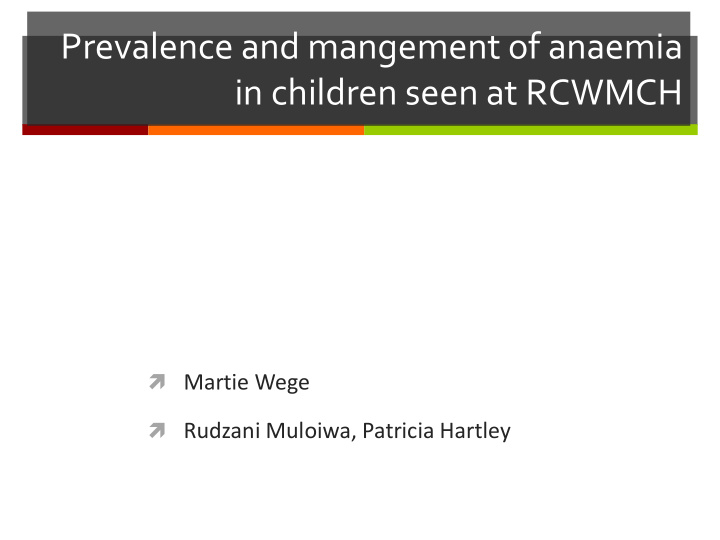



Prevalence and mangement of anaemia in children seen at RCWMCH Martie Wege Rudzani Muloiwa, Patricia Hartley
Introduction: Anaemia is a well known public health problem in children Actual prevalence for anaemia in children from Cape Town remain unclear. Full Blood Count (FBC) is a frequently performed test on children as part of evaluation for other disease processes Anaemia in hospitalized children is usually an incidental finding.
Research Aim: To describe the prevalence of anaemia in children 6-36months of age presenting to MEU, SSW and MOPD at RCWMCH, as well as the management of children with suspected Iron deficiency anaemia.
What is anaemia? Classification of anaemia: For this study purpose: Mild anaemia: Hb ≤ 10.5 for all children Hb 10 – 10.5g/dl 6months to 3 years Case definition for Moderate anaemia: Microcytosis: MCV of 70 fl PLUS 1fl for Hb 8.0 – 9.9g/dl each year 6-12m: 70fl 1-2yr: 71fl Severe anaemia: 2-3yr: 72fl Hb <8g/dl
Selection and sampling of patients: 75 954 • All FBC’s done for 2011&2012 at RCWMCH 36 898 • After dropping all duplicates and FBC’s done during 2011 12 218 • Only keep patients that had their first FBC done at MEU/SSW/MOPD. 2 661 • Exclude all children <6months or >36 months of age • 50% of anaemic patients were sampled 540 • Folders located for a detailed review 502
Prevalence of anaemia in age categories: 100 90 This was in keeping 80 with a 10% decline 70 in the prevalence of anaemia with 60 increase in age 50 category. 40 30 20 RR 1 0,9 (CI 0,84- 10 0.95) 0 All 6-12months 1-2 years 2-3 years Anaemia No Anaemia
Anaemia in different wards Anaemia No anaemia ( χ2p = 0.001 ) 70% 100% 90% 60% 80% 50% 70% 40% 60% 30% 50% 20% 40% 30% 10% 20% 0% 10% 0% MEU (872/2042) MOPD (216/619)
Folder review: Severity of Anaemia at RCWMCH: 11% 36% 53% Mild Moderate Severe
Correlation between Pallor and laboratory confirmed anaemia 91 18% 28 6% No Unknown 383 76% Yes
Folder review: Morphology of anaemia Microcytic Normocytic Macrocytic 2 1% 172 34% 328 65%
Treatment of microcytic anaemia Iron ≤ 1/12 Iron > 1/12 No iron 75 23% 180 73 55% 22%
Causes for anaemia: 400 350 300 250 200 150 100 50 0 -50 Iron Sickle cell Anaemia Pulmonary Specific Thalassaemi Anaemia of Chronic Iron deficiency, Sickle cell anaemia, not Epistaxis Malignancy Haemosider cause not a, Iron prematurity disease deficiency B12 anaemia Iron investigated osis found deficiency deficiency deficiency Causes 365 3 50 1 73 2 1 1 1 1 1 3
Causes for anaemia: 400 350 300 250 200 150 100 50 0 -50 Iron Sickle cell Anaemia Pulmonary Specific Thalassaemi Anaemia of Chronic Iron deficiency, Sickle cell anaemia, not Epistaxis Malignancy Haemosider cause not a, Iron prematurity disease deficiency B12 anaemia Iron investigated osis found deficiency deficiency deficiency Causes 73% 365 3 10% 50 1 15% 73 2 1 1 1 1 1 3
Conclusion: Prevalence of anaemia at RCWMCH 40.8% Anaemia in unwell children at RCWMCH are almost double the predictable prevalence for children in SA Anaemia is significantly more prevalent in younger children The more acutely ill children presenting to RXH are more likely to be anaemic More than 75% of children with suspected iron deficiency received NO iron or ≤ 1/12 of iron A FBC is a frequently performed test on children presenting to the MEU/MOPD at RCWMCH and the information is under-utilized by physicians.
Aknowledgement … NHLS haematology Laboratory at RCWMCH Dr Muloiwa and Prof Hartley
Recommend
More recommend